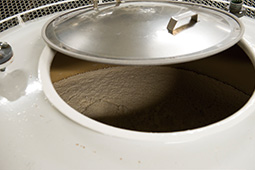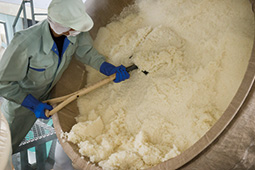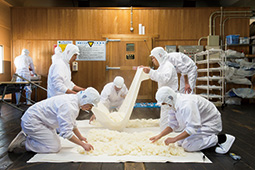INDEX

View from Mount Rokko, the source of Miyamizu 
A stone monument at the place where Miyamizu was discovered 


Inside a Nada sake brewery
April 2021
The Sake of Nada

Nadagogo in southeastern Hyogo Prefecture produces more sake than anywhere else in Japan. The area is known for its rich resources, including the rice, water and skillful artisans that are essential for sake production. The sake produced here at many different breweries is commonly referred to as “the sake of Nada.”

Nadagogo, which spans the cities of Kobe and Nishinomiya in Hyogo Prefecture, has been a location of sake production for around 700 years. “Nadagogo” is a collective name for the five go districts (aggregations of small villages) of Nishi-go, Mikage-go, Uozaki-go, Nishinomiya-go and Imazu-go. Nadagogo covers an area stretching approximately 12 kilometers east to west between Osaka Bay on the south and Mount Rokko on the north. Including some major sake-brewing companies representative of Japan, there are currently twenty-six sake breweries scattered throughout the area. The sake produced in Nadagogo amounts to approximately 24% of the sake shipped domestically (source: 2020 Nadagogo Brewers Association), more than any other brewing area in Japan. In 2018, Nadagogo received approval from the Japanese government for its own Geographical Indication (GI) for Liquor Products.

Iki Tadashi, the managing director of the Nadagogo Brewers Association, says, “Sake production began in Nadagogo in the fourteenth century. Then, sake breweries opened one after another, and sake production gathered momentum in the seventeenth century. This was because of the geographical advantage of facing Osaka Bay, which enabled the shipping of sake by sea to the largest sake-consuming areas of Osaka and Edo (present-day Tokyo). Moreover, quality rice, the raw material in sake production, was readily available, and polishing great quantities of rice for sake production became possible using water wheels, together creating ideal conditions for the production of quality sake.”
According to Iki, Nadagogo was also blessed with abundant groundwater and many toji (master brewers), which are essential elements of sake production.

In around 1840, a sake brewery in Nada discovered a medium-hard groundwater well suited to sake production. This groundwater was later named “Miyamizu” (Nishinomiya mizu [water]) and it became a factor defining the tastiness of the sake of Nadagogo. The people who brew sake in Nadagogo are the Tamba toji, known as one of the three most capable groups of master sake brewers in Japan. The Tamba toji were originally a group of artisans who worked away from the snowy Sasayama area of the Tamba district (the eastern part of present-day Hyogo Prefecture) in the agricultural off-season. They were diligent and sincere, and excelled at brewing. The Tamba toji established a brewing method taking advantage of the properties of Miyamizu and improved the sake’s quality, further building the reputation of the sake of Nadagogo.
In the eighteenth century, great quantities of sake made in Nadagogo were frequently shipped to Edo, Japan’s largest city, by taru-kaisen (cask cargo vessels).



Iki says, “The sake of Nadagogo, which is fermented for a relatively short period, tastes somewhat rough on the tongue in the spring. After letting it sit through summer, it becomes quaffable and mellow. This phenomenon of the sake improving from spring to fall is called ‘Aki-agari’ (also Aki-bare), meaning ‘Clear skies of autumn.’ The sake of Nada has a well-balanced taste and as such goes well with a variety of dishes including steaks made of Kobe beef (a Wagyu brand), sushi and many other local specialty dishes.”
In recent years, Japanese sake has become popular overseas. Nadagogo began exporting sake some decades ago and its sales channels have been established in China, South Korea and other countries. Moreover, the sake breweries are extremely popular destinations for the foreign tourists visiting Kobe and the surrounding areas. In Nadagogo, sixteen breweries offer tours enabling people to study the history of Nadagogo and see actual sake production on-site. Visitors can also taste and purchase fresh sake. Once COVID-19 is behind us, the breweries will again afford visitors the opportunity to enjoy the differences in taste of the various sake brands.

